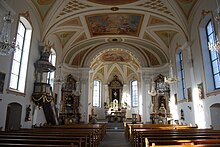St. Verena (Wollerau)
The Catholic parish and the parish church of St. Verena in Wollerau are consecrated to St. Verena . The current church was built towards the end of the 18th century.
history
A Marienkapelle in Wollerau was first mentioned in the tax book of the Diocese of Constance in 1370. Originally the chaplain Wollerau belonged to the parish of Richterswil . After the Reformation, the Bishop of Constance finally raised Wollerau to an independent parish in 1536. In 1779 the pastor at the time, Joseph Franz Kümin, began to collect money for a rectory and the building of a new church. On July 30, 1787, the church was consecrated in its present form.
The church was built during the term of office of the hermit abbot Beat Küttel , a critic of the Reformation and Enlightenment. Like the St. Jakobus Church in Feusisberg , consecrated in 1785, the Wollerau Church is characterized by a special iconographic program that represents the core elements of Catholic teaching in contrast to the Reformed neighboring communities in the canton of Zurich .
Location and appearance
The parish church is located at the central roundabout in the old village center of Wollerau. An octagonal onion crowns the church tower. The tip is marked with a cross and a ball.
inner space
Stylistically, the festive interior can be classified between late baroque ( segmented arched windows , pilasters , organ prospectus , frescoes ) and classicism ( altars , pulpit , baptismal font , stations of the cross ).
The ceiling painting goes back to the father and his sons Messmer. Old and New Testament motifs are juxtaposed. The Assumption and the Coronation of Mary can be seen in the front of the choir . The fresco in front of the choir arch shows the veneration of the Eucharist on all parts of the world. Eucharist and Marian veneration are core elements of the Catholic doctrine and are here in the focus of the pictorial program, clearly distinguishing them from the doctrine of the Reformed neighborhood.
The Wollerau altars were made by the Ticino master Giudici from Saltrio. The high altar can be clearly assigned to classicism , while the two side altars still show clear features of the southern German Rococo . The relics of the catacomb saint Kolumba von Sens are kept in the right side altar . The colorful altars, clad with marble, significantly shape the interior of the church. Especially the high altar, above which a crucifixion painting by the Lucerne artist Josef Reinhard can be seen.
literature
- Albert Jörger: The parish church of St. Verena in Wollerau. (Swiss Art Guide, No. 572). Ed. Society for Swiss Art History GSK. Bern 1995, ISBN 978-3-85782-572-9 .
- Anja Buschow Oechslin: The art monuments of the canton Schwyz. New edition, Volume IV: The district of Höfe. Bern 2010.
- Michael D. Schmid: Demarcation in the border area. Confessional self-presentation. In: etü. Historians' journal. 1/2014, pp. 36-39.
Web links
- History of the parish church of Dr. Werner Röllin on the homepage of the pastoral care room in Berg
Coordinates: 47 ° 11 '45.4 " N , 8 ° 43' 8.5" E ; CH1903: 697022 / 228,013

